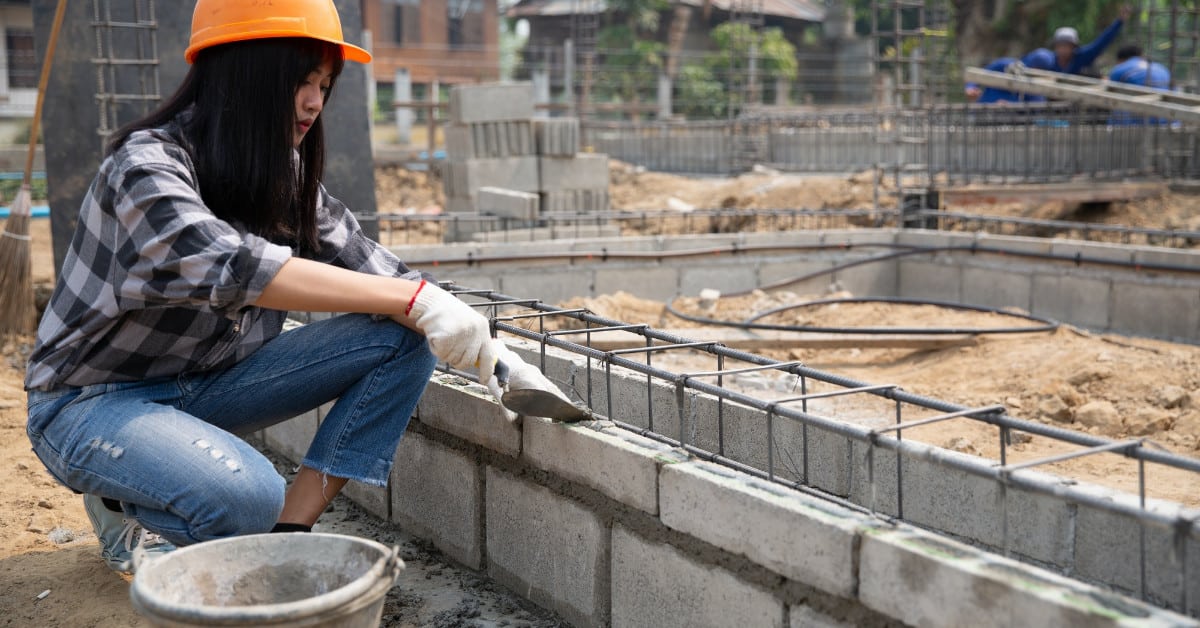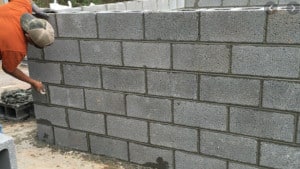Block works are the most critical work for any building construction. Concrete blocks are very typical components of building and are used worldwide. Today the construction industry uses a wide range of sizes and types. Let’s look at some examples of units that are used for blockwork.
The blocks are available in a range of shapes and sizes. The side of the face is normally 450 x 225, the thickness ranges from 60 mm to 150 mm and from 6.3 to 15 kg. They are produced in solid, hollow, and multicut shape. Multicuts allow for the making of a bolster cut without wasting. Walling built with pre-cast blocks can be divided into two main categories, that is, Load bearing as well as the non-load bearing.
Different Types of Blocks
Load bearing blocks are pre-cast into moulds and compacted with vibration aids, or molding machines requiring the use of compressed air, or a mixture of both. Such blocks are typically made of cement and aggregate concrete. The cement is usually Portland cement and using a number of aggregates.
This is also possible to pre-cast non-load bearing blocks in moulds, but others are made in slab shape and cut to size when assembled. Typically such blocks are made from a combination of lightweight materials and cement, such as Breeze or Clinker waste coke, ash, and cement, Burnt clay, etc.
Concrete Blocks
Concrete blocks are flexible, durable, solid, resistant to fire, excellent sound insulation. Ideal background even for dry wet lining finishes and fixations. Inherent thermal mass acts as a store of heat. These methods of building are tested and common, without danger. Available easily and readily and cost-efficient.
Method Statement of Block Work
In this construction activity the materials include:
- Solid and Hollow Concrete Masonry Blocks
- Thermal Blocks
- Sand
- Cement
- Damp Proof Course
- Steel masonry accessories, head ties, lateral ties etc.
- Cement based Non shrink grout etc
Tools Required for Block Work
- Nail Gun
- Table Grinder fro block cutting
- Scaffolding Platforms
- Line dory
- Trowels & Hand tools
- Mixer machine
- Mason square
- Water level
- Wheel barrow
- Masonry saw
- Electric drills
- 3m long Aluminum straight edge
- Spirit level
- Measuring tape
- Plumb bob
- Calibrated survey instruments.
Safety Requirement For Block Work
A scaffold covering the work area is built up to the level of the building before the construction of the block wall. The scaffold shall be built for carrying the material to be used in the construction of the block wall. Scaffolding is erected to allow free access to each mason without being cut off.
All workers working in height must wear lanyard safety belts. There will be barricades in the field where the block operations are carried out.
Installation of Block Work
Ensure the approval for blockwork materials, sample and method statement, and accessories for masonry. Masonry delivered on-site shall be carefully discharged and stored in order to avoid chipping or breakage, and to submit a random test sample.
On plank platforms of sufficient size masonry work units shall be placed in a dry position. Ensure the correct size and location of all supports, bolts, dowels, lintels, blasts, and other built-in products are in place. Before the block work begins, create the existence and location of all MEP openings and items incorporated.
A typical wall style of mock-up wall shall be constructed and a client’s approval shall be given. Following block approval, mock-up works are carried out with masonry. Working in concrete blocks shall suit the approved mock-up wall.
Block Work Procedure
1- The surveyor will mark out the layout for the block work using current layout drawings.
2- In a dry and hot climate, masonry units should be wetted before laying in order to prevent quick drying and shrinkage of cement-based mortars.
3- 200 thick thermal blocks should be used for all the external walls or as per approved shop drawings details.
4-An approved Damp Proof Course (DPC) material should be pre-laid into the base of the wall along the alignment of the block wall. The width of the DPC material should be the same as the particular thickness of the blocks specified on the approved shop drawing.
5- First layer of blocks to be solid blocks and it should be fully set out with proper alignment.
6- Blocks should be properly laid on a full bed of mortar. Mortar joint thickness for the general-purpose mortar will be 8mm to 12mm
7- Mortar made on-site must preferably be mixed by machine
Mortar Mixing for Wall Block Work
1- Mortar mix ratio is 1:6 OPC / Sand for CMU blocks & 1:4 OPC / Sand for thermal blocks or as specified.
2- Add and mix thoroughly and uniformly in enough water to make mortar tightly ball in man’s hand and to lightly ooze through fingers as the hand is closed.
3- Mix no more mortar at a time than can be used within 1.5 hours. Mortar not used within the one & half hour time shall be disposed off. Do not re-temper mortar.
4- Place masonry to lines & levels indicated. Masonry units shall be set out with a storey rod so that coursing lines up at steel shelf angles, sills, heads of windows, and doors with full courses.
5- Masonry units will be assembled together overlapped, so the vertical joints are staggered from course to course. At the corners and wall intersections, the overlapping should be the minimum width of the units. Only cut dimension units will be used at these locations.
6- Horizontal anchors for the masonry block walls will be respected as per specifications.
7- All the horizontal joints should be leveled and the vertical joint shall be aligned during construction.
8- Cutting of masonry should be done by power-driven masonry saw.
MEP Cut out in Block Wall
Maintain openings as per the drawing & cut units to accommodate frames, conduit, fixtures, recesses, and other MEP work inside the wall block work.
Doors in Block Wall
As Work progresses, install metal door frames, fabricated metal frames, window frames anchor bolts, plates, conduits, pipes, and other built-in items into Work. All framework shall be anchored both jams and set plumb and true. Block work should be built to the respective dimension, thickness & height mentioned on the drawing.
Block work Curing
Damp cure the block works for 3 days, lintels and sills for 7 days as per the project specifications.
Block work Cleaning
As the work proceeds, carefully remove mortar splashes from masonry surfaces and adjoining surfaces. After completing each section of the wall block work, clean down surfaces and make good where required.
General Requirement
Walls must also be kept standard. Should not mount wall parts over 1.2 m in height on a particular day. Take walls uniformly, no portion over any adjacent unconstructed course reaches 1000 mm and no wall area higher than 650 mm over any distance which is not absolutely fixed. Angles and discoveries are kept real, square, and plumbing. Broken walls with a lead must be placed up.
Walls shall be built as true planes and, in either direction, shall be positioned within 3 mm and plumb within 4 mm if measured with a direct edge of 3000 mm positioned anywhere on the wall .. Across all the walls around the building, each horizontal joint is equal to the height and level and in accordance with the lines of the designs indicated. Work that is unsatisfactory is removed and replaced.
The walls of a concrete wall intersected in a bond of masonry shall be bound together. Extend the masonry cloths to within 20 mm of the base of the structure unless indicated otherwise. Fill the 20 mm separation distance under 25 percent compression, so that the space on each side of the finishing wall is left for joint damping.
Using the concrete block walls to mount reinforced concrete lintels on openings. At least 200 mm of Lintels shall bear on the masonry support. Place sturdy concrete steel lock blocks on the jambs of the entire block of concrete. The bearing blocks are made of the same material as the outer wall.
See Also
Two Way Slab Design










